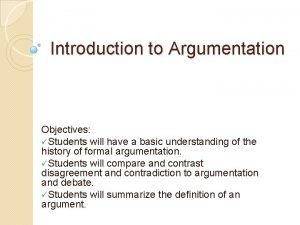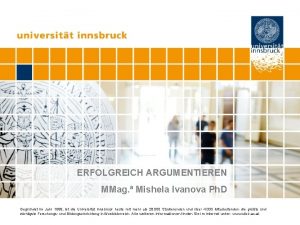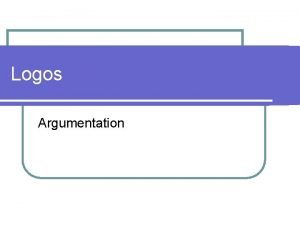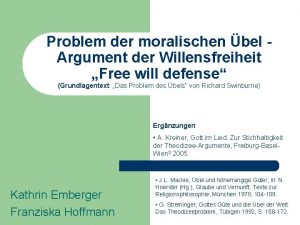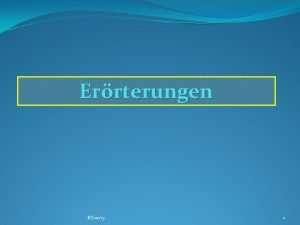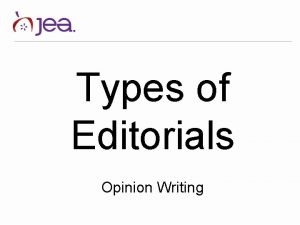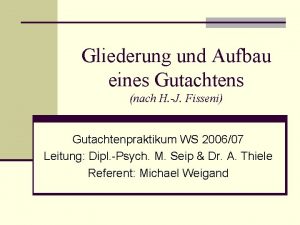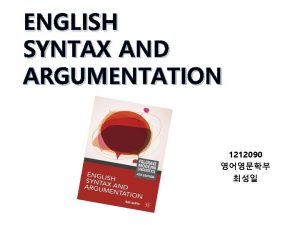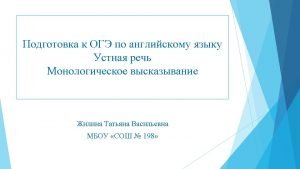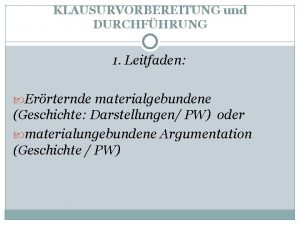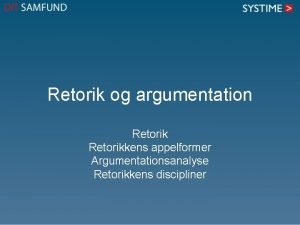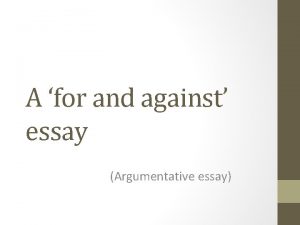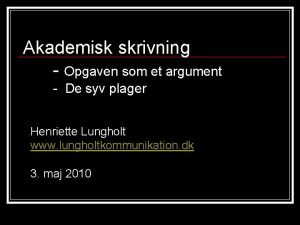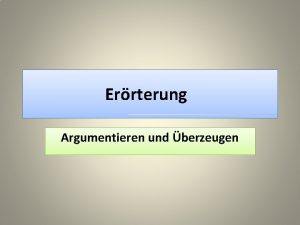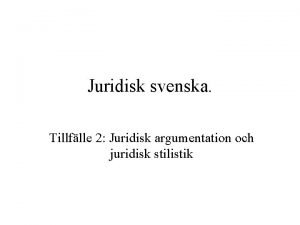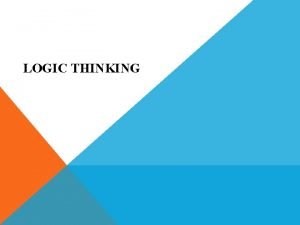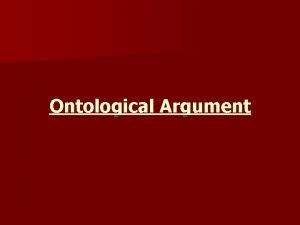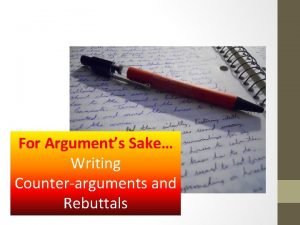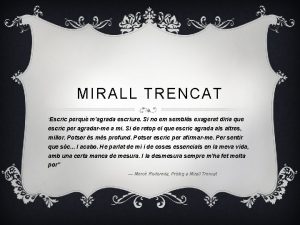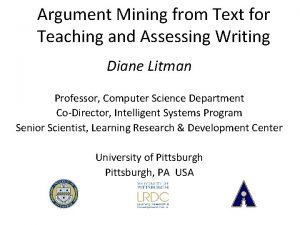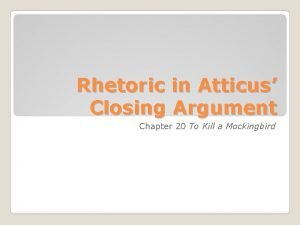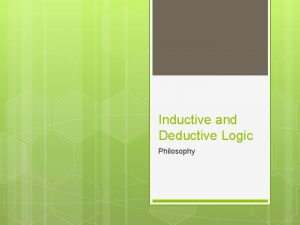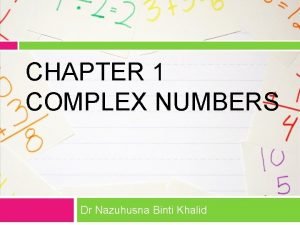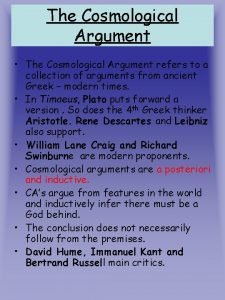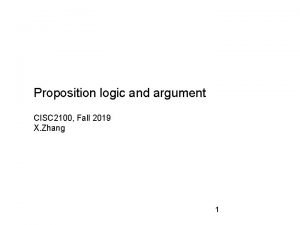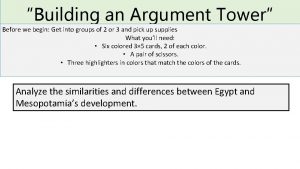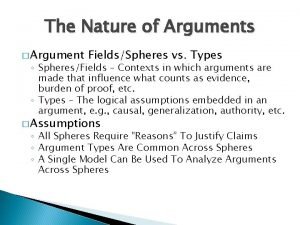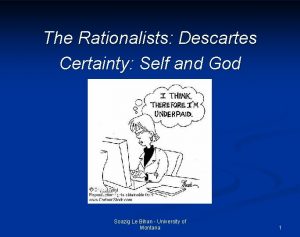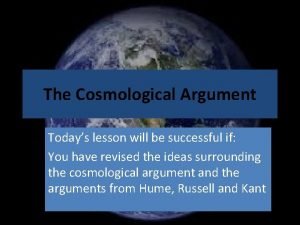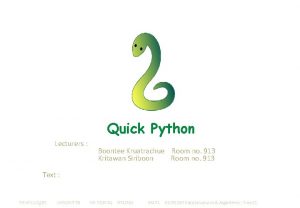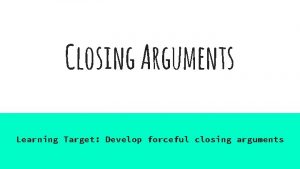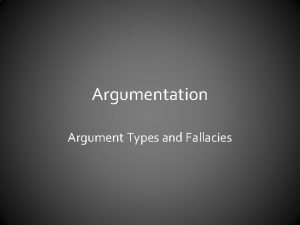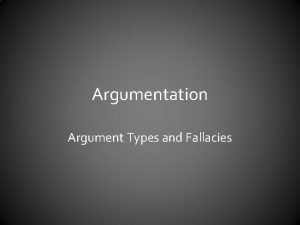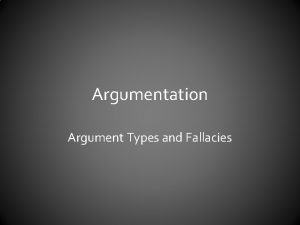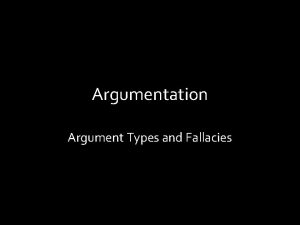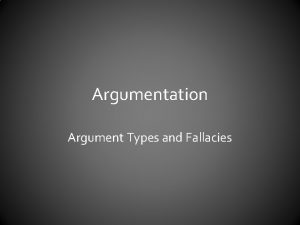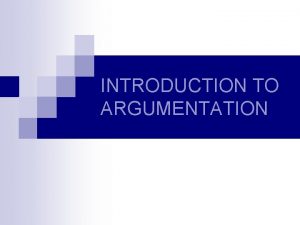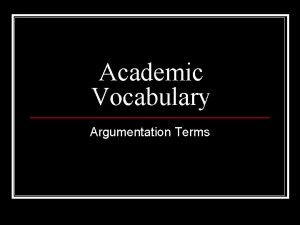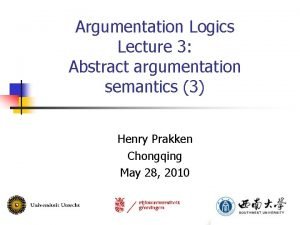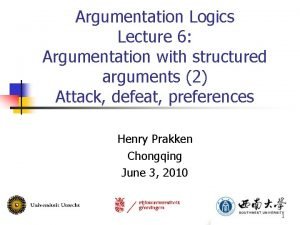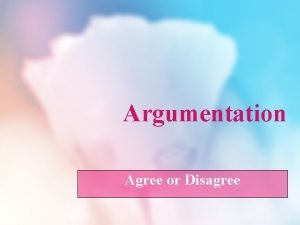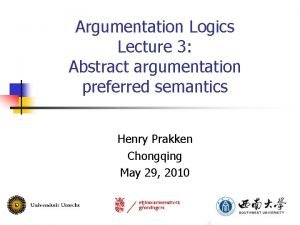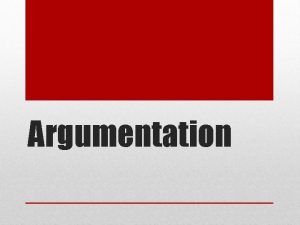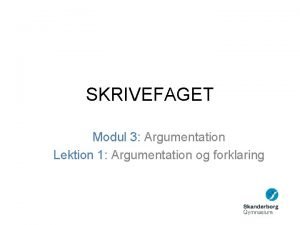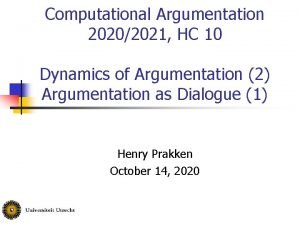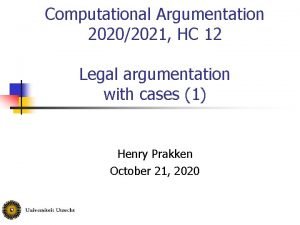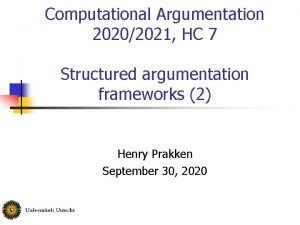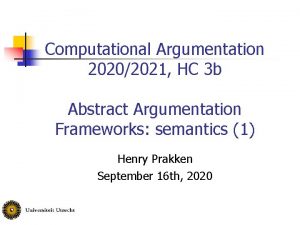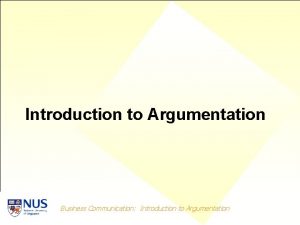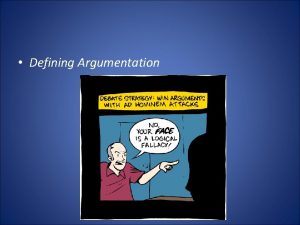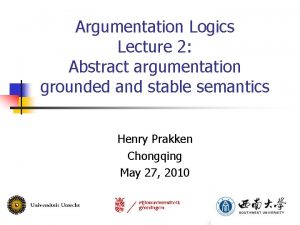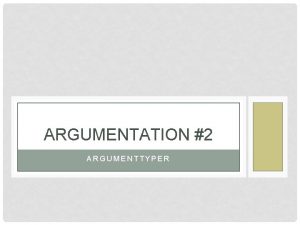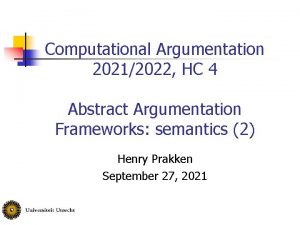ARGUMENTATION What is an Argument An argument is





































- Slides: 37

ARGUMENTATION

What is an Argument? • An argument is a reasoned, logical way of demonstrating that a writer or speaker’s claim is valid. – Valid: well-grounded or justifiable • While many arguments may contain emotional appeals (pathos), your arguments should be primarily logos-driven • Arguments seek to make people believe that something is true or to persuade people to change their beliefs or behavior.

Arguments take many forms… • Verbal/Spoken- speeches (formal) everyday conversations (informal)— real and made up

And… • Written - essays, literature (poetry, novels, short stories)

And… • Visual – pictures, paintings, physical expressions, art

Argumentation v. Persuasion Argumentation Persuasion • Makes claims based on factual evidence • May make claims based on opinion • Makes counter-claims. The author takes opposing views into account. • May not take opposing ideas into account • Neutralizes or “defeat” serious opposing ideas • Ignores, avoids. Or diminishes opposing views • Convinces audience through the merit and reasonableness of the claims and proofs offered • • Often compares texts or ideas to establish a position Persuades by appealing to the audience’s emotion or by relying on the character or credentials of the writer – less on the merits of her or his reasons and evidence. Also, appeals through emotional appeals. • Logic driven • Emotion (pathos) driven ay make claims based on opinion • May make claims based on opinion

Parts of an Arguments • TOPIC/SUBJECT – A generalized matter dealt with in a text, discourse, conversation…argument – EX: the environment, politics, education, social media • ISSUE – A specific problem or controversy (related to the TOPIC/SUBJECT) about which people may disagree. – EX: global warming, socialized healthcare, standardized testing NOTE: Sometimes its best to form the issue as a question—an Essential Question (EQ) which you will set out to answer. Your answer will be your claim/thesis. Your EQ should be even more specific than the issue itself. The more specific your issue, the better your argument will be. – EX: If private schools receive public money, should they also be required to take the same standardized tests as public schools?

Parts of an Arguments • CLAIM – The thesis in an argumentative essay. An assertion of the truth of something, typically one that is disputed or in doubt. A claim is the main argument of an essay. It is probably the single most important part of an academic paper. – Your claim MUST BE DEBATABLE – The complexity, effectiveness, and quality of the entire paper hinges on the claim. If your claim is boring or obvious, the rest of the paper probably will be too.

Claim Continued… – A claim defines your paper's goals, direction, scope, and is supported by evidence, quotations, argumentation, expert opinion, statistics, and telling details. A claim must be argumentative. – When you make a claim, you are arguing for a certain interpretation or understanding of the issue. – A good claim is specific. It makes a focused argument (MTV’s popularity is waning because it no longer plays music videos) rather than a general one (MTV sucks!).

Claim Continued… –Often called position, opinion, belief, conclusion. –Other terms you might hear: • Initial (or working) claim: The claim you start off with • Modified claim: The claim you end up with

Opinion vs. Arguable Claim Opinions • Twinkies are delicious. • I think Virginia Woolf is better than James Joyce. • The governor is a bad man. Arguable Claims • Twinkies taste better than other snack cakes because of their textured creamy filling and their golden appearance. • Virginia Woolf is a more effective writer than James Joyce because she does not rely on elaborate language devices that ultimately confuse and alienate the reader. • The governor has continually done the community a disservice by mishandling money, focusing on frivolous causes, and failing to listen to his constituents.

Tonight… 1. Choose two subject/topics you are interested in… –politics, medicine, social media, the environment, education, etc… 2. Find two debatable issues within that subject that are somehow related to technology. You may want to research. 3. Create an Essential Question for each issue –Example EQ #1: Should school districts allow third parties to collect student data for marketing purposes? --Example EQ #2: Who is financially liable if two driver-less cars crash into one another? NOTE: Inside your Essential Question should be the subject, issue and connection to technology SPECIAL NOTE: You can have an idea about what position you may take on the issue but hold back until you have done some research

Suggestions on Subject, Issue & Claim • Pick a fresh issue, not a tired one. If your are allowed to, choose a issue you are interested in or want to know more about. • Consider what position you will take on the issue but don’t be afraid to change your mind while you do your research – This metamorphosis is the sign of a healthy, rational mind • Think about your readers (audience) and the position they are likely to take. Keep this in mind. • Do basic research and list the arguments on both sides of the issue.

Parts of an Arguments • REASON - Why you think what you think, believe what you believe (usually identifiable after the word “because”) – EX: MTV’s popularity is waning because it no longer plays music videos. – NOTE: Reasons will sound a little like evidence • EVIDENCE (DETAILS) - Reasons are not enough to make an argument. You also need to show your readers specific evidence supporting your reasons. – Often called support or grounds, evidence is how you prove your claim is justified and believable. – The details you provide are what will make your essay vivid. Add to the outline any items of concrete evidence you will include to illustrate and explain your reasoning.

Main Types of Evidence Facts – Using facts is a powerful means of convincing. Facts can come from your reading, observation, or personal experience. – Facts cannot be disputed. This makes them a strong form of evidence. – Note: Do not confuse facts with truths. A "truth" is an idea believed by many people, but it cannot be proven. Statistics (studies, polls) – Using statistics can provide excellent support for your argument. Arguments employing amounts and numbers are concrete and therefore support claims because they use logic and facts. Be sure your statistics come from good sources, which you will cite.

Main Types of Evidence Authoritative Testimony (from Experts) – Using quotes from leading experts or authorities in their fields will support your position—this is a logical appeal and is accepted by other academics as a good way to back up your claims. – It is EXTREMELY important to make sure that the authoritative information you choose is actually accurate and relevant to your point. Sometimes, so-called authorities are not what they seem or information is misleading.

Main Types of Evidence But be careful of your sources • EX: My two friends in Florida think that Miami’s a better place to visit than Chicago. – (Note: these are biased sources. ) • EX: My grandmother, who has property worth over $2 million, believes that estate tax laws need overhauling. – (Note: she’s probably not an expert in tax law, and she has a vested interest. )

Main Types of Evidence • EX: Movie critic Eleanor Lyttle writes that Star Wars Revenge of the Sith is “wondrous” and “a must see. ” – (Note: the actual quotation read: “Revenge of the Sith is a horrific film. It is a wondrous waste, but it is a must-see if you want to understand what a truly bad move looks like. ” In this case, obviously, the quotations are used out of context. ) • EX: Dr. Petrelli endorses energy drinks to boost metabolism. – (Note: who is Dr. Petrelli? )

Main Types of Evidence Example/Anecdotes/Stories (personal and non- personal) – Using examples or anecdotes from others and your own experience can enhance your meaning and also engage the reader. Personal examples make your ideas concrete. – These real-life examples allow a reader to relate to the issues personally.

Other Types of Evidence • Interview – One that you did or a credible source • Analogy (see warrants) – Comparing on scenarios with a like scenario • Observations • Self Studies • Commonly Held Belief (similar to a truth —see warrants)

Introduction to The Toulmin Model A tool for diagramming “informal” arguments

Stephen Toulmin • Stephen Toulmin, originally a British logician, is now a professor at USC. He became frustrated with the inability of formal logic to explain everyday arguments, which prompted him to develop his own model of practical reasoning.

The three basic elements: • Claim (assertion or proposition) • Grounds (proof, evidence, support) • Warrant (inferential leap)

Claims • A claim is the point an arguer is trying to make. The claim is the conclusion, proposition, or assertion an arguer wants another to accept. • The claim answers the question, "So what is your point? ” – example: “Rosario is an American citizen, citizen because she was born in the United States. ” – example: “Barack Obama doesn’t wear a flag pin on his lapel, so he must not be patriotic. ”

More about claims. . . • There are four basic types of claims: • fact: claims which focus on empirically verifiable phenomena • judgment/value: claims involving opinions, attitudes, and subjective evaluations of things • policy: claims advocating courses of action that should be undertaken • definition/classification: indicates what criteria are being used to to define a term or what category something falls into

Evidence (proof or data) • Grounds refers to the proof or evidence an arguer offers. • Grounds can consist of statistics, quotations, reports, findings, physical evidence, or various forms of reasoning – example: “I’m a vegetarian. One reason is that I feel sorry for the animals. Another reason is for my own health. ” – example: “I made the dinner, so you can do the dishes.

More about grounds. . . • Grounds are the support the arguer offers on behalf of his/her claim. The grounds answer questions such as: – – – "What is your proof? “ "How do you know? “ "Why? ” example: “It looks like rain. The barometer is falling. ” falling example: "The other Ritz Carlton hotels I've stayed at had great pools, pools so I'll bet this one has a great pool too. "

Still more about grounds. . . • grounds can be based on: – evidence: facts, statistics, reports, or physical proof – source credibility: authorities, experts, celebrity endorsers, a close friend, or someone's say-so – analysis and reasoning: reasons may be offered as proof – premises already held by the listener

Clue words for identifying grounds • The grounds for an argument often follow words such as “because, ” “since, ” “given that…” – example: “Airports should x-ray all luggage because a bomb could be placed in a checked baggage. ” – example: “I expect to do well on the test, since I studied all night for it. ”

Warrants • The warrant is the inferential leap that connects the claim with the grounds. • The warrant is typically implicit (unstated) and requires the listener to recognize the connection between the claim and grounds • The implicit nature of warrants means the “meaning” of an argument is as much a part of the receiver as it is a part of the message. • Some arguments are “multi-warranted, ” e. g. , based on more than one inferential leap

More about warrants. . . • The warrant performs a "linking" function by establishing a mental connection between the grounds and the claim – example: “Muffin is running a temperature. I’ll bet she has an infection. ” (warrant: sign reasoning; a fever is a reliable sign of an infection) – example: "That dog is probably friendly. It is a Golden Retriever. ” (warrant: generalization; most or all Golden Retrievers are friendly)

Still more about warrants. . . • warrants can be based on: • ethos: source credibility, authority • logos: reason-giving, induction, deduction • pathos: emotional or motivational appeals • value premises: values shared by, or presumed to be shared by, the receiver(s) • note: these categories aren't mutually exclusive, there is considerable overlap among the three

the first triad sample argument 1 The Lakers are likely to win the ballgame tonight Claim They are playing at home Grounds Warrant (unstated) Generalization: The home team enjoys an advantage in basketball

the first triad sample argument 2 It was nominated for 10 Academy Awards “Slumdog Millionaire” is a wonderful movie. Grounds Claim Warrant (unstated) Sign: a movie’s greatness can be measured in the number of Oscar nominations it receives

the first triad sample argument 3 Biff was probably in a fight Claim He has a black eye Grounds Warrant (unstated) Sign: A black eye is a reliable indicator that a person has been in a fight

the first triad sample argument 4 If you surf at Huntington Beach right after it rains you risk getting a bacterial infection Runoff from the rain washes bacteria into the ocean Claim Grounds Warrant (unstated) Cause-effect: bacteria in the water causes surfers to get ill.

Limitations regarding the Toulmin model • The Toulmin model offers a somewhat static view of an argument • Focuses on the argument maker, not the target or respondent • Real-life arguments aren’t always neat or clear • The Toulmin model is an analytical tool – Useful for dissecting arguments before or after they’ve been made – Not as useful, practical in the “heat” of an argument • Since warrants are unstated, different listeners may perceive them differently
 Introduction to argumentation
Introduction to argumentation Induktive und deduktive argumentation
Induktive und deduktive argumentation Logos argumentation
Logos argumentation Free will defense theodizee
Free will defense theodizee Aufbau erörterung sanduhr
Aufbau erörterung sanduhr Editorial type
Editorial type Comment englisch
Comment englisch English syntax and argumentation 연습문제 답
English syntax and argumentation 연습문제 답 Linking words argumentation
Linking words argumentation Eine argumentation
Eine argumentation Retoriske virkemidler eksempler
Retoriske virkemidler eksempler Argumentative essay linking words
Argumentative essay linking words Akademisk argumentation
Akademisk argumentation These
These Stilistisk term
Stilistisk term Types of argumentation
Types of argumentation Argumentation
Argumentation Tierversuche argumentation
Tierversuche argumentation The ontological argument
The ontological argument Counter argument paragraph example
Counter argument paragraph example Mirall trencat argument
Mirall trencat argument Is the teleological argument inductive or deductive
Is the teleological argument inductive or deductive Summary of chapter 1 everything's an argument
Summary of chapter 1 everything's an argument Argument mining
Argument mining Atticus's closing argument
Atticus's closing argument Pintos project 2 guide
Pintos project 2 guide Example of a deductive argument
Example of a deductive argument Complex numbers argument
Complex numbers argument St thomas aquinas cosmological argument
St thomas aquinas cosmological argument Argument forms
Argument forms Statements and arguments
Statements and arguments Argument tower
Argument tower Argument spheres
Argument spheres Cogito2
Cogito2 Rlc strujni krug
Rlc strujni krug Kant's criticism of cosmological argument
Kant's criticism of cosmological argument Typeerror: write() argument must be str, not list
Typeerror: write() argument must be str, not list Forceful argument examples
Forceful argument examples
